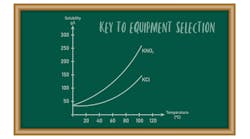The original idea of this column was to give readers practical advice they could use in tackling their day-to-day issues with solids processing. So, my columns have focused on taking a microscopic view of issues such as choosing the best dryer, crystallizer, etc. However, I’ve never provided the big picture of how the various technologies interact with each other. Over the course of this year, I’ll investigate each of the six key solids-processing technologies and focus on their interactions.
These six central technologies are:
• particle separation and agglomeration;
• crystallization;
• solids/liquid separation;
• drying;
• gas cleaning; and
• dry material handling.
A fair amount of crossover exists between material handling and particle separation and agglomeration. Also, I bunch particle separation and agglomeration together as one technology because they rely on fundamentally very similar mechanisms. My emphasis in this technology is on deliberate alteration of particle size, density, color and porosity. Unintentional and, often, undesirable change in the particles, such as attrition, can occur when using the other five technologies. So, this is the best place to start, as it punctuates the good and bad parts of separation and agglomeration.
Attrition has caused more hair graying and loss than any other process. I try to imagine the operation of a piece of equipment and how it appears to the particle. When you see a big impeller coming at you, it’s going to hurt; however, if a lot of smaller particles are around you, they will soften the blow. That’s the reason why removing the fines speeds up a particle grinding operation. Jet mills and even hammer mills use this technique. Retaining the fines results in smoothing over of the rough surfaces of the larger particles and improves the bulk density. Subsequent handling of the particles usually generates less dust.
We had a product that created a dust problem even after separation of the fines. The plant used a ribbon blender to smooth out product variations. However, it was run nearly full. Reducing the fill gave an action that led to more smoothing and improved bulk density by providing more of a rolling and mildly abrasive action. Now, with the fines removed, we observed less dust and the bulk density became more stable.
Attrition plays an important role in pneumatic conveying and pill manufacture. When particles break, it generates new surface that increases their free energy. A subsequent compression of the particles, such as in a tableting machine, releases this free energy to give the tablet more strength. A small amount of attrition even is desirable in pneumatic conveying because the fines cushion the larger particles at the receiver or in bends. If you have trouble getting high strength tablets, consider adding a grinding step before tableting.
Intentional agglomeration is a money-maker for chemical manufacturers, as this one step raises the value of a product — think pharmaceutical powders that don’t have any dust or that don’t leave a bad taste in your mouth. You also can make them dissolve at different places in the gut. I wrote an article on ways to prevent clumping (“Clamp Down on Clumping”); the same advice also is useful in producing agglomerated particles.
Separating particles is one of the simplest operations, but one of the most difficult to control. Screens blind for unexplainable reasons; gravity tables lose alignment; and fluidization devices impart static charges that cause clumping. Solving separation issues requires ingenuity and a lot of trial and error. First, check for mechanical problems such as poor grounding of the device, wear on supports and deteriorated vibratory components. Second, look for static-charged fine particles. If found, you often can neutralize them with an ionization device or an increase in humidity. Third, don’t hesitate to ask for help from the manufacturer of your equipment. We had a screen that carried a lot of fines forward to the coarse material. Our supplier suggested adding a sheet of corrugated metal at the entrance; this stopped the bouncing of the large particles and eliminated the fines carryover.
Next column, I’ll discuss my basic advice on crystallization.


